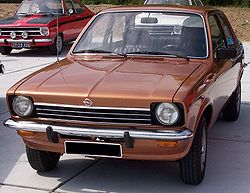    | |
| Production | 1973–1979 |
| Engine(s) | 1.2 1.9 2.0 |
The Kadett C appeared in 1973, and was Opel's version of GM's 'T-Car', also built in Japan by Isuzu and sold as the Isuzu Gemini in Asian markets and Australia and many other names. In South Korea, Daewoo Motors built a version known as the Daewoo Maepsy. The Kadett C formed the basis of the British Vauxhall Chevette, which had a restyled front end, and used a 1256 cc OHV (over head valve) Vauxhall engine rather than the 1196 cc OHV Opel engine. It was notable for the inclusion of a hatchback version named City-Kadett, based on the UK Vauxhall Chevette hatchback, which was a first for Opel. Although Kadett C production ended in 1979, the Chevette was produced until January 1984. Interestingly, the Vauxhall Chevette was imported to Germany starting in 1979 to satisfy the needs of the rear wheel drive traditionalists and was quite a success for a year or two.
The Kadett C today is a cult car in Germany, especially in fastback Coupe form. The most sought after versions of the Kadett C Coupe are the Rallye and GT/E models. These models were built first with the Bosch fuel injected 1897 cc CIH (cam in head) Opel engine and followed by the updated 1998 cc CIH engine. Right hand drive (UK) versions of these sports models are now rarely seen.
A very rare version was the Aero-Kadett, an open-top Kadett with targa roll bar, detachable roof insert and a separate convertible top aft of the roll bar (like the contemporary Lancia Beta Spider (Lancia Zagato in the US). This car was built in very limited numbers by Karosserie Baur in Stuttgart.
The Kadett C reached America as the Buick–Opel. In reality, however, this was an Isuzu Gemini; an updated version of this car was marketed in the USA as the Isuzu I-Mark in the early Eighties.
In Brazil, the Kadett C was released six months before its European release as Chevrolet Chevette, and it was available with a choice of three gasoline engines, a 1.4 L, a 1.6 L and a 1.0 L (available only for 1992 and 1993 model year) and the 1.4 L and 1.6 L were also available on ethanol. This Chevette went through several redesigns - first a front and rear fascia similar to the Opel version, then a look similar to the British/American Chevette, and finally a design reminiscent of the updated American version. It was available in several different bodies: Hatchback (1979-1987), Station Wagon (called Chevrolet Marajó, 1980-1989), Pickup (Chevy 500, 1984-1995) and Sedan (1973-1993). The Chevette sold over 1.6 million units in Brazil, being replaced by the Chevrolet Corsa 

No comments:
Post a Comment